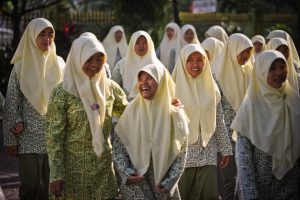Indonesia has the world’s largest Islamic education system. Non-state religious organizations run a vast nationwide network of madrasas alongside government owned non-religious schools. These Islamic schools have made important contributions to the expansion of schooling opportunities, particularly for girls, in remote and underdeveloped communities. Indonesia’s experience can be useful for Afghanistan where, since the return of the Taliban to power, concern has been growing over the “Islamization” of the education sector.
Many fear that either schools will be shut down or girls will be excluded. There have been reports, for instance, of Taliban plans to enforce gender segregation, restrict women’s activities outside their homes, impose hijab norms, and replace schools with traditional madrasas.
However, around the world, millions of girls have been schooled under similar conditions, often inspired by strict interpretations of Sharia law. In particular, Indonesia can serve as an important model for the Taliban of how Muslim nations and faith-based organizations can play an important role in expanding girls’ education.
Just like Afghanistan, Indonesia has allowed madrasas to co-exist side by side with secular schools. However, Indonesian madrasas have responded to societal needs by offering girls’ education long before other Muslim countries like Afghanistan, where most madrasas are still either single-sex, or boys only.
Indonesia’s Ministry of Religious Affairs, hand in hand with the country’s two leading Muslim organizations – the reformist Sunni organization Nahdlatul Ulama (NU) and the education and social charity Muhammadiyah – have created a nationwide network of madrasa-educated women. Setting aside ideological differences, both have historically welcomed female students to madrasas.
Although there has been debate over their quality, Indonesian madrasas have achieved gender parity in school enrollment. There are also more girls than boys at the upper secondary level. Even enrolment in informal or traditional Islamic boarding schools (pesantren) is gender-balanced.
Many parts of Afghanistan remain isolated. Poor digital infrastructure and the lack of state schools mean community-based madrasas remain the only viable option to expand girls’ schooling. Even after the trillions of dollars invested by the U.S. government, around two-thirds of secondary school-aged girls in Afghanistan have been left out of school. Indonesia’s model can be a low-cost solution for state authorities to create educational opportunities for girls.
Another Muslim country, Bangladesh, for instance, has followed the Indonesian model of partnership with madrasas. Today, girls outnumber boys in secondary education in Bangladesh.
What’s more, even before the Taliban’s recent demands on veiling and purdah (female segregation), the Indonesian government had imposed similarly restrictive dress codes on school girls back in 2014.
So an important lesson for Afghanistan from Indonesia – as the world’s largest Muslim-majority country – is that even a preference for Sharia law is not in conflict with the global agenda to educate girls in school.
Partnership with madrasas does in some ways undermine the full transformative power of education. However, Muslim communities should be left alone to negotiate civic rights with their ruling elites. Bringing girls to school is the main priority right now – educated women are the best force for future social change.
In Indonesia, a number of women and parents recently spoke out against an earlier government decision to impose hijab norms. These isolated acts of protest are a byproduct of past investments that Indonesia has made in mass schooling since the 1970s. This has resulted in increasing citizen activism, voice, and a sense of empowerment among Indonesian girls and women.
This shows that, over time, a larger and critical mass of educated women can mobilize on common interests and use their literacy to negotiate better rights with state authorities.
Continuous small acts of protest in Indonesia, for instance, eventually led to a landmark decision earlier this year when the Indonesian government banned schools across the country from forcing girls to wear the hijab.
The diversity in the way that Indonesia has expanded educational opportunities for girls – despite intense conservative religious campaigns at the grassroots level – once again reminds us Islamic traditions alone are no barrier to women’s development.
Therefore, in Afghanistan, a country devastated by war and at an early stage of economic development, the world community should demand that the Taliban bring all girls to school.
In fact, the debate should not be about gender segregation and whether or not to mix religion with schooling. Education should be a priority, regardless of the form and type.
If past trends are sustained, schooling will empower Afghan women and help them mobilize further to negotiate more inclusive schooling in the future.
An earlier version of this article appeared was published by the Conversation Indonesia. It is reprinted with permission.

































